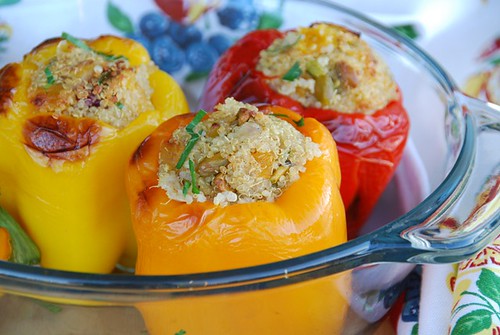 Commonly considered a grain, quinoa (pronounced keen-wah) is actually related to leafy green vegetables such as spinach, swiss chard, beets and tumbleweeds! Once considered the “mother seed” of the Incas, often now referred to as the "gold of the Incas." Quinoa is a nutritional powerhouse, containing all nine amino acids, making it a complete protein. These are not easy to find in the plant world, making quinoa an excellent option for vegetarians, vegans, and anyone interested in adding non-meat proteins to their diet. It is an excellent source of omega fatty acids, vitamin E, B vitamins, calcium, potassium, magnesium, iron, copper, phosphorous, manganese, niacin and thiamine. Quinoa is also naturally Gluten-Free, making it a fantastic food for people following a Gluten-Free diet, and it is high in dietary fiber!
Commonly considered a grain, quinoa (pronounced keen-wah) is actually related to leafy green vegetables such as spinach, swiss chard, beets and tumbleweeds! Once considered the “mother seed” of the Incas, often now referred to as the "gold of the Incas." Quinoa is a nutritional powerhouse, containing all nine amino acids, making it a complete protein. These are not easy to find in the plant world, making quinoa an excellent option for vegetarians, vegans, and anyone interested in adding non-meat proteins to their diet. It is an excellent source of omega fatty acids, vitamin E, B vitamins, calcium, potassium, magnesium, iron, copper, phosphorous, manganese, niacin and thiamine. Quinoa is also naturally Gluten-Free, making it a fantastic food for people following a Gluten-Free diet, and it is high in dietary fiber!Because of all of its nutritional benefits, Quinoa has been used to increase stamina, ease migraines and hypertension, treat childhood asthma, keep gallstones from developing, help with Type 2 Diabetes, protect against heart disease, enhance calcium absorption which can help prevent Osteoporosis, treat arthritis, ease altitude sickness, help prevent Cataracts and benefits both babies and moms during pregnancy and breast feeding. Historically, quinoa has also been turned into a paste and used for inflammation, infection and the mending of bones.
Quinoa has been cultivated in the Andes Mountains for well over 5,000 years. It is grown at high altitudes, can withstand both intense heat and freezing temperatures and requires very little water. In addition, quinoa in its natural state is covered in a bitter-tasting layer of saponins, making it unpopular with birds meaning that the crop remains intact throughout the growing season.
Quinoa is cultivated in three colors, white, red and black and is similar in appearance to couscous. It should be washed thoroughly before cooking to remove the saponins. Quinoa only requires about 10-20 minutes cooking time and is extremely versatile. It is good at breakfast, lunch, dinner or dessert! Try using quinoa as a warm breakfast cereal with fruit, in burritos, soups or stews, casseroles, salads, baked bread, veggie burgers, in place of bulgur in tabouleh, sauteed with veggies, in stuffed peppers, in black bean and corn cakes, in place of rice in pudding and even in brewing beer...the possibilities are endless! We sell a delicious Quinoa Salad with cashews and cranberries, available in our deli! Let's hear your favorite ways to enjoy this well-rounded superfood!





